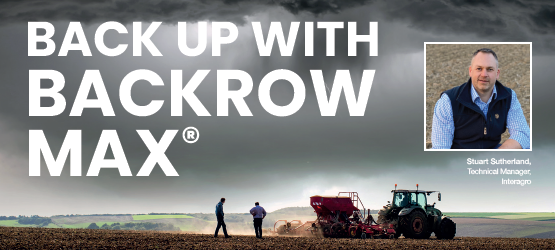With residual herbicide performance at risk from unpredictable weather and challenging application conditions, incorporating an adjuvant into the mix can be a valuable tool within the IPM strategy to help optimise pre-emergence performance and minimise resistance.
Keeping weeds like black-grass at bay can feel like a never-ending battle, and with herbicide efficacy having declined over recent years, many growers have turned to cultural control options like delayed drilling, as well as alternative options like adjuvants to get the most from what chemistry they do have access to.
Among the adjuvant offerings is Interagro’s Backrow Max – a specialist residual herbicide adjuvant that can be incorporated into the pre- and peri-emergence tank-mix to maximise performance – in all conditions. “It not only enhances herbicide coverage across the soil, it also works to consistently maintain a ‘lethal dose’ of active herbicide in the weed germination zone, more effectively than any other residual herbicide adjuvant tested in the market, maximising crop safety and efficacy in adversely wet conditions,” explains Stuart Sutherland, technical manager at Interagro.
Top-performing retention in wet conditions
Research conducted by the Institute of Soil Science and Plant Cultivation in Poland in 2021 and 2022 showed that adjuvants vary greatly in their influence on herbicide retention, with Backrow Max securing the greatest retention in the top 5cm of the soil compared with three competitor adjuvants at their recommended rates, including one of the newer adjuvants, Adhere.
“The research was interesting because it confirms observations in the field, that even active ingredients like pendimethalin can move following heavy rainfall after application. Inclusion of Backrow Max slowed movement significantly,” explains Stuart, with an additional 8% retained in the top 5cm of the soil.

Improved crop safety
As well as better weed control, keeping herbicides in place is also beneficial from a crop and water safety perspective, adds Stuart. “Leaching research conducted in The Netherlands has previously shown that Backrow can reduce chemical leaching by >60%. Given Backrow Max offers even stronger retention in wet soils, it’s the perfect safety net for growers.”
Field trials have also demonstrated benefits in the form of reduced phytotoxicity when Backrow Max is added to the tank, both with Luximo and with Avadex Factor in trials carried out at Stow Longa looking specifically at the crop safety benefits. “Herbicides with high mobility and low adsorption to soil particles pose the biggest threat to crops and groundwater, particularly in lighter soils,” explains Stuart. “But with heavy rainfall, all herbicides have the potential to move down to the crop seed, risking plant health and establishment.”
In the Avadex Factor trial, researchers compared cultivated and non-cultivated wheat plots, with the crop purposely shallow drilled to increase the likelihood of crop damage from the active. In the non-cultivated, direct drilled trial there was 10% crop damage in the form of chlorosis where Avadex Factor was used alone. When the Backrow Max was included there was zero crop damage and an additional 29 wheat plants/sqm.
In the cultivated trial, the Avadex Factor alone was found to cause 20% damage to the crop but with the Backrow Max, this was avoided – and once again showed no evidence of chlorosis. As a result, there were an additional 11 wheat plants/ sqm.

Winning the weed war
The benefit of all of this is the valuable added efficacy to herbicide activity, meaning growers are able to improve both weed control and reduce seed return. For example, “Trials have shown 12% higher black-grass control with Octavian Met (diflufenican + flufenacet + metribuzin) plus Pontos (flufenacet + picolinafen) in winter wheat, and 4% higher with Luximo,” explains Stuart. Some of the best results have been seen when applied with Liberator plus Proclus (aclonifen).
In this trial, the Backrow Max improved blackgrass control by an impressive 22%. It has also been proven to enhance control of ryegrass
and brome in winter wheat as well as annual meadow grass in spring barley and broadleaved weeds in multiple crops. “We’ve actually found that in dry conditions – which prohibit the movement of residual herbicides into the weed zone – Backrow Max can be as effective as an inch of rain when it comes to improving pre-em performance.”
With lots of growers reporting late weed flushes and higher pressures than usual this year, Stuart concludes that any tools which can be used to help keep burdens at bay are a “no brainer”. “The efficacy and options when it comes to herbicides are ever declining and it is vital to protect what we do have available.
Adjuvants play a key role in this and have the potential to make a real difference when it comes to getting the most out of chemistry.”


